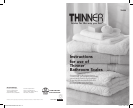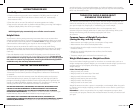
INSTRUCTIONS FOR USE
How To Operate
1. Check to make sure your scale is set to measure in “lb”. (lb/kg switch on back of
scale should be set to “lb”. If scale does not have a switch, it is automatically
set to measure in “lb”.)
2. Place the scale on an even, flat surface for accurate operation and safety.
3. Step onto the scale and stand on platform without shifting or moving until weight is
displayed (display blinks, then shows your weight).
NOTE: Digital display automatically turns off after several seconds.
Helpful Hints
Your Thinner
®
scale is a precise measuring instrument that is most accurate when
weighing a stationary object. To ensure the most accurate readings always try to stand
on the same area of the scale platform and DO NOT MOVE. Should the weight on the
scale exceed the scale’s capacity, you may see an error message ”ERR”.
Electronic sensors are sensitive. Be careful not to drop or jar the scale. Place it
gently onto floor surface, and store where it will be protected from impact. The scale is
an electronic instrument and should never be submerged in water. Clean with damp
cloth only.
If the scale batteries need to be replaced, lift the battery cover on the bottom of the
scale and replace the old batteries with 4 new alkaline AAA batteries. Do not mix old
and new batteries. Properly dispose of the old batteries. Do not attempt to open
the scale or to remove any components. Servicing should be done by qualified
technicians only. See warranty information below.
LIMITED TEN YEAR WARRANTY
Conair will repair or replace, at our option, your appliance free of charge for
120 months from the date of purchase if the appliance is defective in workmanship
or materials.
To obtain service under this warranty, return the defective product to the service
center listed below that is nearest you, together with your sales slip and $5.00 for
postage and handling. California residents need only provide proof of purchase and
should call 1-800-3-CONAIR for shipping instructions. In the absence of a receipt, the
warranty period shall be 120 months from the date of manufacture.
ANY IMPLIED WARRANTIES, OBLIGATIONS, OR LIABILITIES, INCLUDING BUT NOT
LIMITED TO THE IMPLIED WARRANTY OF MERCHANT ABILI TY AND FITNESS FOR
A PARTICULAR PURPOSE, SHALL BE LIMITED IN DURATION TO THE 120-MONTH
DURATION OF THIS WARRANTY. Some states do not allow limitations on how long an
implied warranty lasts, so the above limitations may not apply to you.
IN NO EVENT SHALL CONAIR BE LIABLE FOR ANY SPECIAL, INCIDENTAL, OR
CONSEQUENTIAL DAMAGES FOR BREACH OF THIS OR ANY OTHER WARRANTY, EXPRESS
OR IMPLIED, WHATSOEVER. Some states do not allow the exclusion or limitation of
special, incidental, or consequential damages, so the above limitation may not apply
to you. This warranty gives you specific legal rights, and you may also have other rights
which vary from state to state.
THINGS YOU SHOULD KNOW ABOUT
MANAGING YOUR WEIGHT
Diet, exercise, and determination all play a part in effective weight management. Your
scale is the tool that lets you chart your progress, and measure your success, whether
your goal is weight loss, weight gain, or maintaining your current weight.
Because weight varies, as explained below, focus on the progression and
sustained long-term changes rather than on exact day-to-day readings. When you’re
dieting and exercising, small, fluctuating weight gains and losses
are common.
Common Causes of Weight Fluctuations
(during the day, and day-to-day)
• Water retention and weight gain from consumption of large meals
• Water retention from salt and carbohydrate intake
• Muscle buildup (muscle weighs more than fat) from strenuous
resistance training
• Weight loss caused by dehydration due to illness, low fluid intake
or strenuous exercise
• Temporary weight gains and losses from menstrual cycle
Weight Maintenance vs. Weight Loss/Gain
Get into the habit of weighing yourself no more than once a week when you’re on a
weight management program. Weighing in at consistent intervals will give you the most
accurate picture of your progress, eliminating many short-term, unrelated
weight changes.
Follow These Simple Rules
• Weigh yourself once a week.
• Weigh yourself on the same day of the week.
• Weigh yourself at the same time of day.
• Weigh yourself wearing the same clothes.
• Weigh yourself in the same place.
• Weigh yourself on the same scale.
Weight fluctuates more when a person is overweight or underweight. When the goal is
to maintain current weight, weighing yourself more than once a week is a good way to
stay on track.
Remember: A scale is an essential tool in any weight management program, but it
only records your progress. Exercise, diet and determination are what you need to reach
your goal.
09AD14680 TH328 IB mech.indd 3-4 6/18/09 3:26:14 PM




